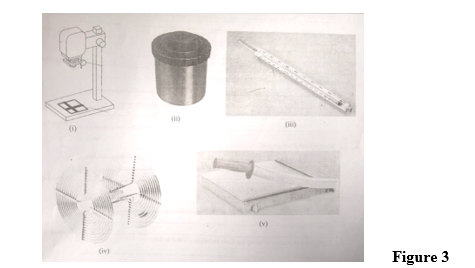Question 3:
- Identify the darkroom equipment labelled in 3(a)(i-v).
- State one function each of the equipment identified in 3(a).
- In which areas of the darkroom can any four of the equipment identified in 3(a) be found?
- What is photo lamination?
- State any two advantages of photo lamination.

The question was attempted by few candidates whose performance was poor. The candidates were expected to write the following points as answers to the question:
(a) (i) - Enlarger.
(ii) - Developing tank.
(iii) - Thermometer.
(iv) - Reel/film reel/Spiral spool.
(v) - Trimmer/guillotine/cutter/paper cutting machine.
(b) (i) Enlarger
- Used to expose negative on to a photo/printing
paper for production into a photograph.
(ii) Developing tank
- A tool used to process/develop film in
analogue/traditional photography.
(iii) Thermometer
- Used to measure the temperature of the processing
chemicals in the darkroom.
(iv) Reel/Film Reel/Spiral Spool
- An assessory used to load exposed film for processing
into a negative and usually placed inside a developing tank
(v) Trimmer/guillotine/cutter/paper cutting machine
- Used to trim prints or cut negatives to the desired sizes.
(c) - Enlarger is found in the dry area of the darkroom.
- Developing tank is found in the wet area of the darkroom.
- Thermometer is found in the wet area of the darkroom.
- Reel/film reel/spiral spool is found in the wet area of the darkroom.
- Trimmer/guillotine/cutter/paper cutting machine is found in the dry area of the
darkroom.
(d) Photo lamination is a process of spreading a thin layer of clear/transparent
film on a print to protect it from moist, scratches or finger prints.
(e) - To protect it from moist and dampness.
- To ensure that finger tips do not get to the main picture.
- To avoid scratches on the image surface.
- For aesthetic purpose.
- It could extend the lifespan of a photograph if exposed to direct sunlight.
- Prevents photographs from folding and creasing at the edge or tearing.
